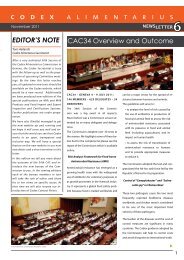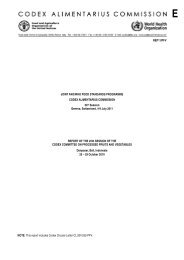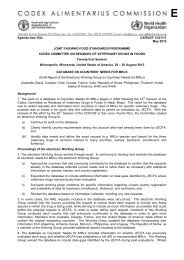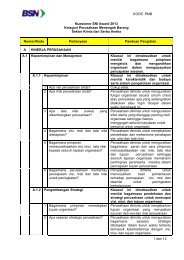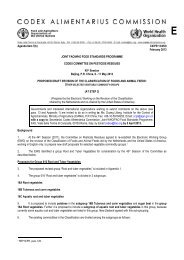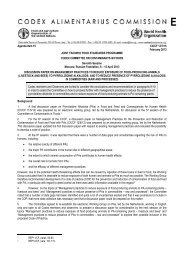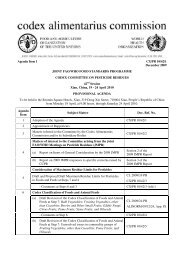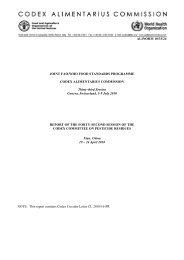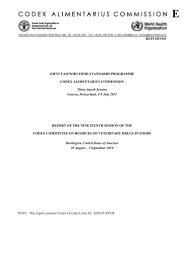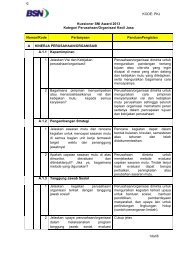Agenda Item 16 CX/CF 13/7/16 February 2013 JOINT FAO ... - FAO.org
Agenda Item 16 CX/CF 13/7/16 February 2013 JOINT FAO ... - FAO.org
Agenda Item 16 CX/CF 13/7/16 February 2013 JOINT FAO ... - FAO.org
- No tags were found...
You also want an ePaper? Increase the reach of your titles
YUMPU automatically turns print PDFs into web optimized ePapers that Google loves.
<strong>CX</strong>/<strong>CF</strong> <strong>13</strong>/7/<strong>16</strong> 3<strong>16</strong>. Examples of varieties found to contain high levels include shark (all species), swordfish/broadbill (Xiphias gladus), marlin(Makaira species, Tetrapturus species) and orange roughy (Hoplostethus atlanticus). Some species of tuna can also contain highlevels, such as big eye (Thunnus obesus), blue fin (Thunnus thynnus) and albacore tuna (Thunnus alalunga), although the averageconcentrations tend to be significantly lower than in the fish varieties listed above. Pike (Esox lucius), tilefish (Caulolatilus princes)and king mackerel (Scomberomous cavalla) from certain geographic locations can also contain relatively high levels of mercury.Mercury levels in canned tuna are often lower than in fresh tuna, largely due to the species or because smaller-sized fish are used.Skipjack tuna (Katsuwonus pelamis) is often canned and this variety tends to contain lower levels of mercury. However, species withhigher levels may also be canned, such as albacore tuna (Thunnus alalunga) known as canned ‘white’ tuna in some countriesincluding the US).17. Available data collected on mercury in fish are largely for total mercury rather than methylmercury. In most fish, methylmercurycan contribute more than 90% of the total mercury content; hence total mercury is generally a good indicator of methylmercuryexposure. In this paper unless otherwise defined a reference to mercury means total mercury.18. Using available data the Expert Consultation analyzed the composition of fish by developing a matrix comparing the levels of theLCn3PUFAs DHA and EPA with levels of total mercury.19. A significant correlation was found between the fat and EPA plus DHA concentrations.20. No significant correlation was found between the mercury content and content of another compound.21. A compiled data set created by the Expert Consultation in 2010, including the arithmetic mean content of total fat, EPA plus DHAand total mercury for 103 fish species, can be found in Appendix A of the report of the Expert Consultation 5 , while it should be notedthat, as the Expert Consultation pointed out, evaluation of the analytical quality of the samples is not possible in terms of analyticalmethods.EXPOSURE22. The 67 th JE<strong>CF</strong>A reported intake estimates close to and sometimes exceeding the PTWI of 1.6 μg/kg body weight (4). Valuesranged from 0.3 to 1.5 μg/kg body weight per week for the five regional GEMS/Food diets and from 0.1 to 2.0 μg/kg body weight perweek for numerous nationally-reported diets.23. In general, consumers who eat average amounts of varied fishery products are not likely to be exposed to unsafe levels ofmethylmercury. However, people who eat appreciably more than average amounts of certain types of fish are more likely to exceedthe recommended safety thresholds. Mercury toxicity in high consumers has been reported (7). In particular, based upon monitoringdata, population groups who frequently consume top predatory fish, such as shark, swordfish and some species of tuna, may have aconsiderably higher intake of methylmercury and exceed the PTWI.24. The Expert Consultation in its risk-benefit estimations uses one, two, three or seven servings of fish per week, typicalconcentrations of EPA plus DHA in different fish species and existing health based guideline levels for methylmercury, and assumesa serving size of 100 grams.25. The recent EFSA opinion concluded that the mean dietary exposure across age groups in Europe does not exceed the (new)TWI for methylmercury, with the exception of toddlers and other children in some surveys. The 95 th percentile dietary exposure isclose to or above the TWI for all age groups. High fish consumers, which might include pregnant women, may exceed the TWI by upto approximately six-fold. Unborn children constitute the most vulnerable group. Biomonitoring data from blood and hair indicate thatmethylmercury exposure is generally below the TWI in Europe, but higher levels are also observed. Exposure to methylmercuryabove the TWI is of concern. If measures to reduce methylmercury exposure are considered, the potential beneficial effects of fishconsumption should also be taken into account.26. In Australia, in 2011, the most recent dietary exposure estimates indicate that dietary exposures to methylmercury are below thePTWI of 1.6 μg/kg bw for all age groups at the 90 th percentile, and consequently within acceptable safety standards. The highestlevel of exposure was for 2-5 year olds at 80% of the PTWI, because of their high food consumption relative to body weight. Due tothe potential adverse effects of methylmercury on vulnerable population groups, such as pregnant women and young children,methylmercury will continue to be monitored in future studies.S eafoods were major sources of methylmercury exposure for all agegroups. Fish (uncrumbed/unbattered or canned) contributed 42-53% of total methylmercury exposure in children 12 years andyounger. Battered seafood contributed 41-44% of total methylmercury exposure for those aged <strong>13</strong> years and over.27. In Japan, the results of a total diet study for mercury under the normal dietary conditions showed an estimated average dailyintake of total mercury to be 8.17 µg/person from 1999 to 2008. This value is below the re-evaluated PTWI of JE<strong>CF</strong>A.28. In China, the results from 2007 total diet study for total mercury and methylmercury under the normal dietary conditions showedan estimated average of 0.068 µg/kg bw weekly and 0.041 µg/kg bw weekly, respectively, which are far below the correspondingprovisional tolerable weekly intake (PTWI).5 See http://www.who.int/foodsafety/chem/meetings/jan2010/en/index.html




